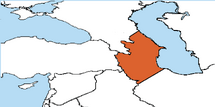| The following page is under construction.
Please do not edit or alter this article in any way while this template is active. All unauthorized edits may be reverted on the admin's discretion. Propose any changes to the talk page. |

|
This Yellowstone: 1936 page is a Proposal.
It has not been ratified and is therefore not yet a part of the Yellowstone: 1936 Timeline. You are welcome to correct errors and/or comment at the Talk Page. If you add this label to an article, please do not forget to make mention of it on the Main Discussion page for the Timeline. |
| |||||||
| Capital (and largest city) |
Baku | ||||||
| Language official |
Azeri, Russian | ||||||
| others | Kurdish, Farsi, | ||||||
| Religion | Zoroastrianism, Shia Islam, Orthodox Christianity | ||||||
| Ethnic Groups main |
Azeri, Georgian, Armenian, Russian | ||||||
| others | Kurds, Russians, Persians | ||||||
| Demonym | Azeri | ||||||
| Duke | Shahin Hasanzedah | ||||||
| Population | 14,236,137 | ||||||
| Currency | Azeri Rial | ||||||
Azeropedagon encompasses Russia's Caucasus region. Most of the people are of Shi'ite Islam, Orthodox Christianity, or Zoroastrian faith, with the Shi'ites making up the majority. Azeropedagon is currently an autonomous region of the Holy Russian Empire, as of 1958.
History[]
Reclamation of Azeri Lands[]
Following the Eruption many government collapses, and many insurgents arose. One of these insurgents was Hasan

Azeropedagon after the war with Iran.
, a Zoroastrian from a small tight knit community (in OTL Azerbaijan, but at the time it was Soviet Russia). During the Eruption the small community was devastated, with much of the populace dying off, Ilkin manages to survive and moved to Baku in 1938. There he began preaching of rebellion against the USSR and its weakened government, and also Zoroastrianism. The charismatic youngster grew in both followers and converts, and managed to stage a large result known as the Caucasus Revolt, with only freeing much of Azerbaijan by 1942. In February 1943 after recovering from the previous war and supporting nationalists in Iranian Azerbaijan Hasan decided to attack and retake the Azeri lands. The Azeri Reconquest took fife years and ended in the April of 1948 Hasan decided to name his new nation Azeropedagon, the ancient name of Azerbaijan which translates to "Guardians of the Fire."
Post Reclamation[]
After the lands were reclaimed Ilkin focused more on internal affairs and keeping stability in the state. He began to institute a tax program of lesser taxes, with the tax range varying from 18%-30% and began to subsidize farms, orchards, ranches, slaughterhouses, and railroad companies. His plan was to both bring a steady food supply and improve/repair infrastructure. The plan, later known as the Reclamation Plan, is known for its success in improving the infrastructure, but only mild success in improving food supply.
During the this time the government also found the state-run Ministry of Community, whom took care of religious and cultural issues (e.g. religious violence) while officially siding with no one religion or culture in particular, as the state was decreed secular. The Ministry of Faith at this time began building temples in cities to attempts to bring about a sense of community and friendship among the people. During this period the Ministry supposedly was bias toward Zoroastrianism, and began to build a great amount of Zoroastrian temples, but a minimal amount of Shi'ite temples. As the people were for decades being forcefully deconverted by the USSR or converted to Orthodox Christianity by the Russian Tsardom the Shi'ite community was in shambles, and the loss of faith due to hard times after the Eruption. The large increase in Zoroastrian church and community and the weakness of the Shi'ites led to mass-conversions of Zoroastrianism. This policy continues for decades up until the 1980s.
Expansion[]
In June 1950 another war was launched to take back the Caucasus from the remaining USSR, but as the nation collapsed so fully there was very little resistance and the war it was over by November 1950. Another war was then launched against Turkey to take greater lands which was begun in March 1951 and ended in January 1952, as the Turkish government was weakened as well.
Orthodox Genocide.[]
In the years following 1953 religious violence has been a large issue in Azeropedagon, as Ilik Hanzedah Reziah began what would be known as the Orthodox Genocide. During the mid-1950's the government took on a anti-Armenian and anti-Georgian propaganda campaign, with the Zoroastrians being anti-Armenian and anti-Georgian due to ancient ethnic and cultural clashes, and the Shi'ites being anti-Orthodox after centuries of Orthodox oppression and religious issues.
This caused most of the early violence done by citizens against the western Orthodox peoples. During the Winter of 1955 there was a food shortage, and government propaganda spouting that it was due to the Orthodox Church hoarding their food sparked outrage, and almost two weeks of rioting in Western Azeropedagon killed thousands of Orthodox Christians, and the fallout continues to today, with murder over religion not being uncommon.
Later during the Spring of 1956 the government began forcefully sterilizing and killing not only the Orthodox but even Shi'ite and Zoroastrian Armenians and Georgians. Many were shipped to mining labor-camps, were accused of false crimes and imprisoned, had their houses burned down, or just plain shot when out at night. It wasn't until the Autumn of 1956 that Armenians and Georgians were abducted and sent to hard labor in the mines and farms, or to concentration camps. Many Orthodox fled north to the Orthodox peoples of Russia, or to Iran, Iraq, and Turkey where they were tolerated more and it was warmer. The total amount of Georgians and Armenians killed or exiled exceed two million.
HRE Integration[]
Integration into the Holy Russian Empire began in 1958 in which the Tsar demanded that Azeropedagon become one with the HRE peacefully. Azeropedagon agreed reluctantly, seeing the might of the HRE. In the Treaty of Baku Azeropedagon officially became a autonomous region in the Holy Russian Empire under the circumstances that Azeropedagon become autonomous, and the Shah be downgraded to a Duke under the HRE.
Modern Day[]
Since the Russian integration of Azeropedagon the region has seen a spike in its economy. Azeropedagon is

A picture of Baku, Azeropedagon's capital.
naturally a very mineral-rich and oil-rich nation, but in the past was under-developed to get sizable portions of the materials, or had fewer trading partners, as both Turkey and Iran disliked the small nation. After Russia took over the region one of the first things that happened was mines and oil fields opened up around the Duchy. The creation of jobs and precious materials turned the 3rd World State into a economic powerhouse. The average GDP Per Capita is at $53,200, with it being $12,560 at the time of the Duchy's integration.
Culture[]
Religion[]
Much of the population is Shi'ite, making up about 54% of the population making it the most common religion, the second most common are the Zoroastrians making up about 17%, and the Orthodox Christians making up 26%, 3% other.
Language[]
The Azeri language is one of the many mixing-pot languages that can be found world wide. The language originally was mostly Persian, then it was strongly influenced by the Armenians, Greeks and Byzantines. Later the Mongols and Tartars came, bring with them their own language. Then even after the Mongols came the Russians the first time. The language today also uses Cyrillics rather than Arabic characters, as during the integration Azeropedagon was forced to adopt Cyrillics.
Human Rights Issues[]
Racism[]
Azeropedagon is a hot bed for racism. As Azerbaijanis are the conquerors and uniters of the Caucasus they are often the higher class, with Georgians below them, then Armenians beneath them. Along with being ethnically prejudice, it is also religiously prejudice. Zoroastrians are almost always upper class, and most nobles are Zoroastrian. It is not uncommon for an Zoroastrian Azeri to kill an Orthodox Armenian with a bias investigation in which the Azeri goes free.
Shi'ite Azeris are the most common and usually middle-class. Though they are not Zoroastrian, they are considered respectable and are considered the second highest class. Shi'ite Azeris are usually not discriminated against by Zoroastrians (unless there is another Zoroastrian in the mix) and often discriminate against the Orthodox, Georgians and Armenians.
Oppression[]
Geography[]
Azeropedagon in the Caucasus region and is almost completely mountainous save for plains to the north.
| ||||||||||||||||||||



